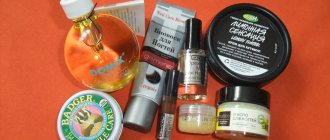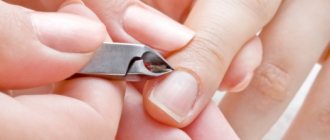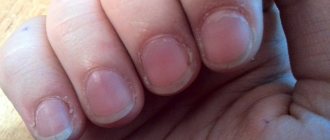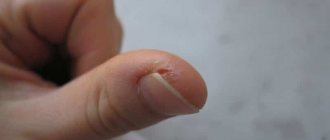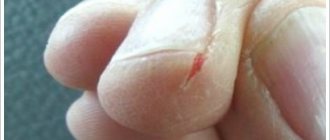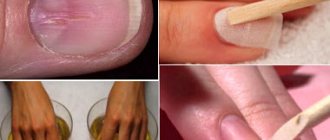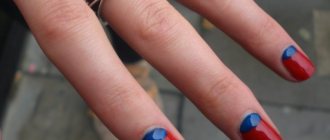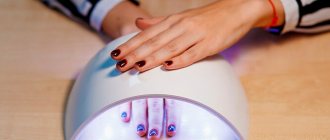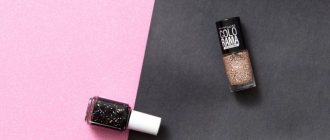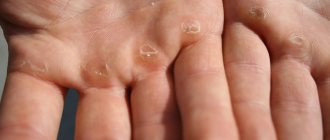Injuries, fungal infections, improper nail care - all this can cause damage to the plate and require its surgical removal. This procedure does not pose a great danger, but it is accompanied by extremely unpleasant symptoms and discomfort in humans.
Read on in the article to find out how long a toenail grows after its removal, and how to speed up this process.
Features of nail regrowth
How quickly toenails grow is largely determined by the following factors:
- The age of the person. Older people's nails take longer to grow. At the same time, the plate itself is often rougher and delaminates. This significantly complicates the process of nail care.
- Nutritional features.
- Basics of therapeutic therapy and nail care.
- The complexity of the surgical intervention and the degree of neglect of the primary nail disease.
- The root cause for which surgical treatment was required. It is known that if the nail was removed due to injury, then there is a high probability that soon after the skin heals, the stratum corneum will begin to develop. It will take 6-12 months to completely restore a healthy nail.
- Features of skin regeneration, which may be different for each person.
- Immune status of the body.
- Season of the year. According to observations, it was revealed that in summer and autumn the body is more saturated with vitamins, due to which nails grow faster. The situation changes in winter and early spring. In this case, all energy will be directed to supporting the immune system and fighting seasonal colds.
- The nail removal technique used, as well as the presence of complications. Thus, operations using laser are less painful and traumatic than open surgery. The recovery period for the nail after them is quite fast.
Features of growth
Human nails, like animal claws, are made of keratin. This is a special protein that is involved in the construction of not only nails, but also hair. The nail grows from the base next to the cuticle; the nail plate, on which the manicure is performed, is inanimate.
Each nail has a white "crescent" at the base, called a lunula. The lunula is a group of cells that synthesize the production of keratin, thus being responsible for nail growth. Thus, new tissue from the lunula is, as it were, “added” to the old one, displacing it from the surface of the nail bed. This way the free edge of the nail is formed. It acquires a rich white (normal) color because, leaving the nail bed, it loses its base, which is supplied with blood vessels.
The cuticle is necessary to protect the lunula from mechanical stress. That is why its incorrect trimming can cause a decrease in the growth rate and deformation of the nail. Damage to the lunula itself can even cause a complete stop in growth, since it is the lunula that is responsible for how long fingernails grow.
It has been noted that the rate of growth of nails and hair decreases with age. This is due to the fact that all processes in the body and cells slow down, including the production of keratin. In children, the rate of nail growth depends on age and the presence of calcium and other essential vitamins for nails in the body. For example, during periods of active growth, nails may grow faster.
If you are concerned about why your fingernails are growing so quickly, then we can conclude that most likely this is due to one of the reasons listed below:
- Changes in hormonal balance;
- Pregnancy;
- Diet change;
- Frequent washing of dishes and other reasons for keeping nails in a damp environment or directly in water.
If it is necessary for the growth rate to decrease, then all work in water can be done using rubber gloves. In addition, the rate of nail growth under gel or shellac is significantly reduced due to the lack of oxygen access to the plates. Thus, if you want to slow down the growth rate in order to wear extended nails without correction for as long as possible, then you should not do this. After all, it will decrease on its own immediately after the procedure.
[yandex2] [google2]
How long does it take for a nail to grow?
It is impossible to say exactly how long it will take for a healthy nail to fully grow back. This process is purely individual and occurs differently for each person.
So, in children under six years of age, a new nail can be completely restored in just 4 months. In adults, this process can take up to a year. Moreover, if the nail bed has been injured, the plate may grow unevenly and be uneven.
Within a month, the nail grows on average by 3-4 mm.
Nails grow slowest in older people who suffer from severe chronic diseases that lead to depletion of the body (infectious diseases, vitamin deficiency, diabetes mellitus).
Attention! To speed up the process of nail regrowth, it is useful to take vitamin complexes, some of which will include vitamin B.
"Brazil Avenue" - series.
Production: TV Globo, Brazil, 2012. Premiere: 03/26/2012.
Number of episodes - 179.
Premiere on Channel One - 06/03/13. (On August 2, 2013, the broadcast of the series in Russia was stopped due to low ratings. According to representatives of Channel One, Channel One does not have budget funding and lives on money received from advertising, and its cost directly depends on the popularity of projects on air. According The results of showing the first 50 episodes do not justify the purchase of new episodes of Prospekt Brasil. In Russia, of course, there are fans of Brazilian series, but their number is not enough for a national channel).
Actors and their roles:
- Deborah Falabella - Rita/Nina;
- Adriana Estevez - Carminha (Carmen Lucia);
- Murilo Benicio - “Typhoon” (Jorge Araujo);
- Kahua Raymond - Jorginho / Batata / Christian;
- Héloïse Perisse - Monalisa;
- Marcela Novaes - Max (Maxwell);
- Vera Oltz - Mama Lucinda;
- Jose de Abreu - Neil;
- Eliana Giardini - Murisi;
- Markus Caruso - Leleko;
- Leticia Isnard - Ivana;
- Natalia Dill - Deborah;
- Isis Valverde - Suelen;
- Bianca Comparatu - Betania;
- Otavio Augusto - Diogenes;
- Paula Burlamaki - Dolores / "Soniña Catatau";
- Ailton Graca - Silas;
- Alexandra Borges - Cadinho / Dudu;
- Carolina Ferraz - Alexia;
- Deborah Block - Veronica;
- Camila Morgado - Noemia;
- Daniel Rocha Azevedo - Roni (Ronikita);
- Thiago Martins - Leandro;
- Deborah Nascimento - Thessaly;
- Bruno Gizzoni - Iran;
- Emiliana D'Avila - Lucio;
- Fabiola Nascimento - Olenka;
- Julian Casarra - Adauto;
- Cacau Protasiu - Zeze;
- Claudia Missura - Janaina;
- Carolina Abras - Begonia;
- Luana Martau - Beverly;
- Felipe Abib - Jimmy;
- Andre Luis - Valentin;
- Ronnie Krivat - Thomas;
- Bruna Grifau - Bruna;
- Joao Fernandez - Picole.
Children:
- Mel Maya - Rita (Nina as a child);
- Bernardo Simoes - "Batata" (Gorginho as a child);
- Ana Carolina Lunn - Agatha.
And:
- Tony Ramos - Genesio;
- Jean Pierre Noer - Martin;
- Daniel Kuznieka - Hector;
- Betty Faria - Pilar;
- Juca de Oliveira - Santiago.
Description of the series
The main character Rita/Nina is the daughter of an entrepreneur (Tony Ramus), married to the villainess Carmine (Adriana Estaves), who, together with her lover Max (Marcelo Novaes), rob Ramus’ hero. One day he finds out everything, but dies in an accident due to the fault of football player Typhoon (Murilu Benicio). Carminha sends the girl to the landfill, and with the help of Max, she wins Typhoon’s love and becomes his wife. At the landfill, little Rita meets a boy named Batata, and their childhood love begins. Batata turns out to be Carminha's son, whom she takes from the landfill when she becomes Typhoon's wife. Rita is also taken from the landfill by her adoptive father and taken to Argentina. Years later, engaged to an Argentinean, she returns to Brazil to settle scores with Carminha. Little does Rita know that she will meet again not only Carminha, but also her childhood love, Batatu, who has turned into heartthrob Jorginho (Kaua Raymond), who in turn is engaged to Deborah (Natalia Dill). The man she has loved all her life turns out to be the son of the woman she hates with all her heart.
Additional Information:
- description of the episodes of the series "Brazil Avenue";
- the official group of the series “Brazil Avenue” on the social networking site “VKontakte”;
- soundtrack.
Sources:
- latinoparaiso.ru - information about the TV series “Brazil Avenue”;
- www.vokrug.tv - “Brazil Avenue”: Channel One apologized to fans of the series;
- tvnovella.ru - information about the series “Brazil Avenue”;
- vk.com - performers of roles in the series “Brazil Avenue”.
Nutrition for nail growth
To speed up the process of growing healthy nails, the menu should be enriched with the following beneficial microelements and vitamins:
| Microelement name | Where is it contained? |
| Vitamin A | cod liver, quail eggs, butter, broccoli, feta cheese, cottage cheese |
| Vitamin D | Fish oil is the leader in terms of content. The vitamin is also found in mushrooms, yolks, and herring. |
| B vitamins | greens, green vegetables, potatoes, beans, nuts, cereals, chicken, bananas |
| Vitamin PP | turkey meat, seafood, seeds, nuts, river fish, squid, sesame |
| Calcium | hard cheese, almonds, cottage cheese |
Worth knowing! The rate of growth of nails on the toes is slower than on the hands. Moreover, it is known that the nails on the working hand (for most people the right hand) grow more slowly.
How does the nail growth process occur?
Nails are keratinized tissues formed in the form of a plate. Located on the back of the ends of the fingers both the upper and lower extremities, most primates have them.
The function performed by the nail plate is to protect the ends of the phalanges of the fingers. This arrangement is caused by the need to protect soft tissues and nerve endings located among them from damage. These protection products are made of a protein called keratin. Such explanations are given by encyclopedias.
Keratin is the main building element not only of the nail plate, but also of hair.
If you believe Darwin's theory, then our ancestors are monkeys. In these primates, protective plates at the ends of the fingers can serve for defense and climbing trees. They're almost like claws.
The nail plate does not have blood vessels or nerve endings, therefore, this tissue is non-living. But at the same time it can grow. The plate is made from more than a hundred keratinized plates by layering one on top of the other.
The semicircle at the base of the nail is called a lunula. It is here that the cells that produce carotene are located, that is, they form new fragments of the plate. The location of the lunula is clearly visible in the photo:
In a lunula, new produced tissue is added to an existing part. At the same time, the nail is pushed forward - it grows. There is a narrow area of skin above the lunula. It is called the cuticle. This protects the lunula and the base of the plate from bacteria entering them, as well as from mechanical impact.
With age, the growth process of the plate slows down. Often during this period, all sorts of patterns, dots, lines or dents begin to appear on or under the nail. The reasons for this manifestation lie in the body, which thereby signals internal problems. It is the plate that first begins to show its owner that he has some kind of disease.
Biologically, the growth process of fingernails and toenails is no different. There is a difference in the speed of their regrowth.
A very interesting illustration, in it the growth zone is called not a lucula, but a hole, which is also acceptable:
This is how nails grow. Click on the picture to enlarge!
This video will help you figure out the issue; it also gives recommendations for accelerating growth:
Recommendations from experts
To speed up the process of nail restoration and wound healing, you should follow these tips:
- perform dressings and apply a sterile bandage every day;
- avoid getting moisture and dirt into the wound (to do this, you should maintain foot hygiene and avoid visiting the pool);
- apply healing ointments to the wound;
- If purulent discharge appears, consult a doctor immediately;
- Avoid using compressive shoes during the recovery period.
What determines the growth rate?
Delayed nail growth can be caused by many factors:
- genetic predisposition or pathological changes in the body at the genetic level;
- taking certain medications;
- illness;
- lack of vitamins;
- injuries sustained by the nail plates.
However, not every disease is a cause that has a depressing effect on the growth process of the nail plate. Past infectious diseases often activate nail growth. At the same time, causing the same effect on purpose is a difficult task.
In order for the nail plates to look beautiful and healthy and delight the eyes of not only the owner, but also those around her, they require timely and proper care.
By applying a manicure or pedicure day after day, without giving the nails a chance to “rest,” their owner causes irreparable harm to the protectors of the phalanges of the fingers. And the next diets for weight loss are again missing vitamins, so necessary for the normal growth of nail plates. If they could talk, they asked the hostess: how long can this last?
Pharmacy and folk remedies
To relieve the inflammatory process and speed up the wound healing process after nail removal, you can use the following recipes:
- Dissolve 100 g of sea salt in 1 liter of water. Use for baths.
- Make a steep decoction of chamomile. Soak a bandage in the product and apply it to the wound twice a day.
- Dilute Dimexide with Novocaine in a ratio of 1:3. Use for lotions.
- Apply Heparin ointment to prevent hematoma.
- Mix salt and soda. Pour boiling water over it. Use for baths.
- Make a decoction of plantain and yarrow. Make lotions from the prepared product.
During the period of nail growth, it is useful to lubricate the plate with sea buckthorn oil to speed up the regeneration process.
(
2 ratings, average: 5.00 out of 5)
